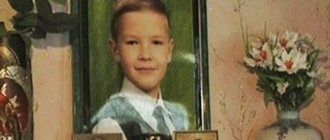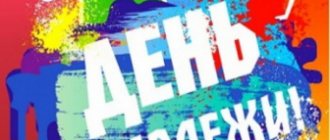Class hour "Battle of Stalingrad"
Title of work: Class hour “Battle of Stalingrad” Author: Patrina Vera Nikolaevna Place of work: MKOU “Secondary general education with in-depth study of individual subjects school No. 5”, city district, Frolovo Extracurricular activity: class hour. Topic: “Battle of Stalingrad” Duration: 45 min. Class: 2. Technologies: presentation. Class notes. Objectives: 1. To clarify and expand students’ knowledge about the Battle of Stalingrad and its significance during the Great Patriotic War. 2. Develop interest in the history of the Fatherland, the history of your native land; observation, curiosity. 3. Foster a sense of patriotism, cohesion, and responsibility. Preparation for class: multimedia presentation, design of a book exhibition. Students are preparing reports about the courage of Soviet soldiers during the Battle of Stalingrad. A group of readers selects poems about war, courage, and heroism. A group of music designers - videos about the war. Progress of the class hour. - Today is an unusual day. Maybe some of you know why? (children's answers) - Today is February 2, 2012. 69 years ago the Battle of Stalingrad ended. (1 slide) - And our lesson, guys, is also unusual. You are attending a lesson in courage. - How many of you guessed why the lesson was named that way? (children's answers) - Today we will take an excursion back into the history of the city of Volgograd. — What was the name of the city before? (Tsaritsyn, Stalingrad, Volgograd) - So, the city of Stalingrad. An ordinary city. Now they say pre-war Stalingrad. Civilians lived in the city. Look at the screen. (2 slide) (music video “Holy War”) - On August 23, 1942, German planes subjected Stalingrad to a barbaric bombardment. In one day, the enemy carried out more than 2,000 sorties. Despite the opposition of Soviet aviation and anti-aircraft artillery, which managed to shoot down 120 fascist planes, the city was turned into ruins, and over 40 thousand civilians died. August 23, 1942 is the most mournful date in the history of this city. (3 slide) - Not only buildings were burning, the ground and the Volga were burning, as oil tanks were destroyed. It was so hot in the streets due to the fires that the clothes of people running for cover caught fire. (4.5 slide) - In such conditions, people selflessly fought against fascism. Today we will remember some of them by name. — Maybe some of you know the heroes of the Second World War? (children's answers) (Children read prepared reports) Panikakha Mikhail Averyanovich (1918 - 10/2/1942) Born in Ukraine. Drafted into the ranks of the Red Army by the Tsarichansky district military registration and enlistment office of the Dnepropetrovsk region in 1939. He arrived to defend Stalingrad as part of the fighters of the Pacific Fleet. Private (squad commander of the 883rd Infantry Regiment, 193rd Infantry Division). Non-partisan. On October 2, 1942, in the Panikakha area, Bederov and his front-line comrade were in a trench advanced to enemy positions. From the direction of Mamayev Kurgan, German tanks went on the offensive. The battle ensued unequally. The fighter only had two bottles of flammable liquid “KS” left. Then M.A. Panikakha, taking them, crawled forward. An enemy bullet hit the bottle raised by the sailor and the liquid, spreading over the soldier, ignited him. Overcoming the pain, Mikhail jumped onto the lead tank and burned down along with its crew. The Soviet soldier died a heroic death. The remaining German tanks and infantry turned back. Mikhail was buried in a deep crater, near. The feat of Mikhail Panikakha became known throughout the country. Panikakha was awarded the Order of the Patriotic War, 1st class, posthumously. (6,7 slide) Vasily Grigorievich Zaitsev Vasily Grigorievich Zaitsev was born on March 23, 1915 in the village of Eleninka, Kartalinsky district, Chelyabinsk region, into a peasant family. Russian. He graduated from seven classes of junior high school. In 1930 he graduated from a construction college in the city of Magnitogorsk, where he received a specialty as a reinforcement engineer. Since 1937, he served in the Pacific Fleet, where he was assigned as a clerk in the artillery department. After studying at the Military Economic School, he was appointed head of the financial department in the Pacific Fleet, in Preobrazhenie Bay. The war found him in this position. By the summer of 1942, Petty Officer 1st Article Zaitsev submitted five reports with a request to be sent to the front. Finally, the commander granted his request and Zaitsev left for the active army. On a September night in 1942, along with other Pacific soldiers, Zaitsev crossed the Volga and began to participate in the battles for the city of Stalingrad. He knew how to choose the best positions and disguise them; usually hid from enemy soldiers in places where they could not even imagine a Russian sniper. The famous sniper hit the enemy mercilessly. Only in the period from November 10 to December 17, 1942, in the battles for Stalingrad, V. G. Zaitsev destroyed 225 enemy soldiers and officers, including 11 snipers, and his comrades in arms in the 62nd Army - 6000. Zaitsev was especially glorified by sniper a duel with the head of the Berlin sniper school, Major Koenings, who was sent to Stalingrad with a special task to intensify the sniper movement in the German troops. (8,9 slide) Yakov Pavlov - On the evening of September 27, 1942, Yakov Pavlov received a combat mission from the company commander, Lieutenant Naumov, to reconnoiter the situation in a 4-story building. With three fighters (Chernogolov, Glushchenko and Aleksandrov) he managed to knock the Germans out of the building and completely capture it. Soon the group received reinforcements, ammunition, and a telephone line. Together with the platoon of Lieutenant I. Afanasyev, the number of defenders reached 24 people. The Nazis continuously attacked the building, trying to smash it with artillery and aerial bombs. Skillfully maneuvering the forces of a small “garrison”, Ya. F. Pavlov avoided heavy losses and for almost two months did not allow the enemy to break through to the Volga. On November 25, during the attack, Ya. F. Pavlov was wounded in the leg. He was in the hospital, then fought as a gunner and commander of the reconnaissance department in artillery units. He was awarded two Orders of the Red Star and medals. Soon after the end of the war (June 17, 1945), junior lieutenant Ya. F. Pavlov was awarded the title of Hero of the Soviet Union. (10, 11,12, 13, 14 slide) Filippov Alexander Alexandrovich (06/26/1925 – 12/23/1942) Sasha was born in 1925 in the city of Stalingrad. When the war began, four of his brothers went to the front. In the summer of 1942, in the second year of the difficult war, Sasha was 16 years old, and he already had a specialty as a mechanic and shoemaker. German soldiers broke into the Voroshilovsky district and occupied the area where the Filippov family lived. At night, Sasha contacted the military unit of Senior Lieutenant Seminikhin, to whom he brought intelligence information about the enemy. So, Sasha became a scout under the nickname “schoolboy”. With a bag over his shoulder and a shoemaker's tool, Sasha went around the German headquarters to repair the boots of the Germans. He works during the day, looking out for everything, and at night he makes his way to the headquarters, and grenades fly through the window. After the explosion, the Germans are running around looking for partisans, and Sasha is playing “classes” with the children on the street. Sasha went behind enemy lines many times. On December 23, 1942, after completing the mission, he returned with intelligence officer Maria Uskova. While crossing the front line, they were captured by German soldiers. After much torture, the Nazis hanged Sasha along with Uskova and an as yet unknown young partisan not far from the house in front of his mother. Before his death, Sasha managed to shout: “All the same, our people will come and kill you like mad dogs!” Posthumously, Sasha was awarded the Order of the Red Banner and the medal “For the Defense of Stalingrad.” He was buried in the park of the Voroshilovsky district; a monument to him was erected at his grave. In Volgograd, the street where he lived, the school where he studied, and the square where he is buried are named after him. (15 slide) Vladimir Vasilyevich Zemlyansky Born on November 21, 1906 in Moscow. Russian. After graduating from the workers' school, he worked at a factory. In the Armed Forces since 1926. In 1927 he graduated from the Leningrad Military Theoretical School, in 1928 from the Sevastopol Military Aviation School, in 1933 from advanced training courses for command personnel. He served at the Tambov Military Aviation School of Pilots. In the active army during the Great Patriotic War since December 1941, when Major Zemlyansky was appointed commander of 622 caps. The regiment under his command went through the combat path, being part of the 66th army of the Southern Front, 228th unit of the Southwestern and Stalingrad fronts. During this period, Major Zemlyansky made 45 combat missions, as a result of which 100 enemy tanks and several hundred vehicles were destroyed, the fire of several dozen anti-aircraft batteries was suppressed, 2 crossings were destroyed, and more than a battalion of infantry was partially destroyed. 08/07/42, during an attack by enemy tanks breaking through from the south to the outer defensive perimeter of Stalingrad, Zemlyansky showed an example of courage and fearlessness, destroying several tanks and vehicles with targeted fire. During the last approach, his Il-2 was hit by anti-aircraft artillery fire. The attack aircraft's engine caught fire and control was lost. And then Zemlyansky radioed the command to his deputy to lead the group, and he himself directed the burning plane towards a concentration of enemy troops. (16,17 slide) Kamenshchikov Vladimir Grigorievich Born on March 18, 1915 in Tsaritsyn, in a working-class family. Russian. In 1931 he graduated from the factory apprenticeship school at the shipyard. He worked as a turner in a locomotive repair depot. In 1934 he graduated from the military construction technical school. In 1937 he graduated from the 7th Stalingrad Military Pilot School. Participated in the liberation of Western Ukraine and Western Belarus. He took part in the Great Patriotic War from June 1941. He was an adjutant of the 126th IAP squadron of the 9th Garden of the Southwestern Front. In the spring of 1942, Major Kamenshchikov was appointed deputy commander of the 788th Air Defense Fighter Regiment[4] of the 102nd Air Defense Fighter Division, Stalingrad Air Defense Corps Region. Flew on the Yak-1. In mid-July 1942, fierce battles broke out in the Stalingrad direction, in which the city's air defense aircraft took an active part. The enemy launched the first bombing raids on Stalingrad at the end of July 1942 in groups of 20–45 aircraft at an altitude of 2000–5000 meters. These raids were carried out sporadically, and anti-aircraft artillery repelled them relatively easily, preventing the enemy from dropping bombs on defended objects. During this period, the fighters of the 102nd Fighter Aviation Division had to operate in very difficult conditions, since the 8th Air Force had not yet arrived.” In August 1942, Major Kamenshchikov shot down Ju.88 and He.111 personally and three Bf.109 fighters in a group. By this time, he had flown 256 combat missions, shot down 20 enemy aircraft personally and 17 in a group. In battles he was seriously wounded twice. (18 slide) - Yes. Our soldiers did not stand behind the price; they fought to the death. You all know that the Battle of Stalingrad was the turning point of the war. The Battle of Stalingrad is one of the heroic pages in the history of our people. In a fierce battle, people showed personal and collective heroism. Mass heroism confused the enemy. The Germans did not understand its reasons, its roots, its origins. The exploits of ordinary Russian soldiers frightened the enemy and instilled feelings of fear in him. Reading the pages of history, getting acquainted with the exploits of people, you are amazed at their dedication, strength, will, and courage. What guided their actions? Love for the Motherland, desire for a bright future, sense of duty, example of comrades who fought shoulder to shoulder. — The commander of the tank unit sets new offensive tasks. (19 slide) - Tanks are moving to the battle lines. (20 slide) - Submachine gunners hold the mountain pass. (21 slides) — Street fighting began in the burning city. (22 slide) - Workers of industrial enterprises defending their hometown. (23 slide) - The southern group of German troops, which included Paulus, capitulated on January 31, 1943. (24 slide) - Banner in honor of the victory of the Soviet troops. (25 slide) - Mamaev Kurgan. (26 slide) Students read the poem Sorrow... I once saw a guest on the mound: Taking off the darkening scarf from her head, She took two handfuls of earth from the mound And tied the earth into a knot... And with that familiar, constant pain, She immediately became shorter in stature and weaker, I stood quietly for another minute at the monument to my Mother, to myself... (27 slide) There is silence on Mamayev Kurgan. There is silence on the Mamaev Kurgan, There is silence behind the Mamaev Kurgan, The war is buried in that mound, A wave quietly splashes onto the peaceful shore. (28 slide) V. Ledneva “Eternal Flame”. Now you can’t hug them, you can’t shake their hand. But an unquenchable fire arose from the earth - Sorrowful fire, Proud fire, Bright fire. These are the fallen hearts that give up their bright flame to the living. (29 slide) - Military actions destroyed almost the entire housing stock of the city - 42,000 buildings. Many foreign statesmen and journalists who visited Stalingrad sincerely believed that it could not be restored. (Slide 30) - The city was practically empty. In six urban areas, which before the war were home to about half a million people, on February 2, 1943, there were one and a half thousand residents. People lived in basements, dugouts, ruins of houses. (31 slide) - Thanks to the residents, the city was restored. (32 slide) (The clip “I have the honor...” plays) List of sources used. 1.https://battle.volgadmin.ru/ 2.https://ru.wikipedia.org/wiki/ 3. https://www.warheroes.ru/Stalingrad.asp 4. https://www.molodguard .ru/forum/viewtopic.php?f=28&t=319 5.https://www.togur-school.tom.ru/site1/stalingrad.htm 6.https://forums.airforce.ru/showthread.php ?t=3330&page=2 7. https://www.stalingrad-battle.ru/ 8. https://frend.org.ua/post135753594/ 9. https://geroiros.narod.ru/wwsoldat/OPER/ ARTICLES/018-stalingrad.htm 10.https://samsv.narod.ru/Oper/1942/stalingr.html 11. https://www.pageranker.ru/forum/showthread.php/1209-%D1%F2 %E0%EB%E8%ED%E3%F0%E0%E4%F1%EA%E0%FF-%E1%E8%F2%E2%E0?s=566dd1c38fb5ecd8a7028d2e101d551c 12.https://www.otvoyna.ru /itogi_stal.htm 13. https://viki.rdf.ru/item/2428/ 14.https://viki.rdf.ru/item/1520/


